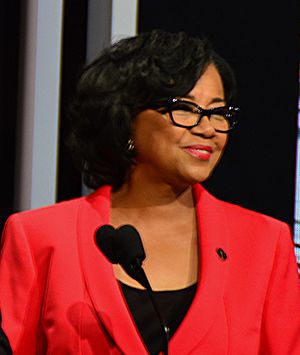Addressing the challenges of diversity, next-generation/breathless content and bringing along tomorrow’s visual storytellers; the Society of Motion Picture and Television Engineers (SMPTE) Conference showed there’s a lot of progress taking place behind the scenes.
Women in Tech
Since I live my life on the techie side of the business, I’m big on acronyms and often refer to Women in Technology as WIT.
But they have to have some WIT or their lives would be “a little strained.”
The luncheon has become a SMPTE mainstay where women discuss how they got into the business and their experiences in the male-dominated industry.
That’s fine for ladies but a little awkward for guys. But being a big part of the problem, getting the subject out in the open may help us be part of the solution.
To give attendees a lift, Cheryl Boone Isaacs, the third-term president of the Academy) of Motion Picture Arts and Sciences (AMPAS, or as the in-crowd calls it “The Academy”) discussed her winding path to the top.
She’s the first African American and third woman to head the organization, so some progress is being made.
At the Women in Technology luncheon, Boone Isaacs recounted her winding path in the industry and highlighted many of her industry inspirations.
The late ‘80s, early ‘90s seemed to be open season for female executives in the small, closely knit entertainment industry such as Sherry Lansing at Paramount; Dawn Steel at Columbia Studios; Lucie Salhany at Paramount TV; and other female executives who influenced Isaacs.
Isaacs said that was a period when the door started to close. Now, the shift/emphasis is on diversity and “normalcy.”
“We all work in a pretty tight and small world,” she noted. “And when you’re on the set, in post … you’re hyper-focused on what needs to be done. Sometimes, it takes a bit more effort to look outside your normal space … at those outside of your circle,” she added.
Her current mission is to go beyond the producer and director and make people understand the other options in the industry — editing, sound, visual effects, etc. – that keep the industry moving forward.
On the positive side, Isaacs said that the M&E business is getting the message that women exist – even over the age of 30, 35. She sees a lot of opportunities to shine the light on a wide range of issues and it’s not about the message but that people really like a good story.
She was optimistic that the newer content delivery systems will accelerate both the diversity across the business and the different genres of film to emerge and prosper. But she added, “If it’s not going to make any money, the studios are not going to make it.”
Isaacs also touched on two areas we have been thinking about – nurturing the next generation of filmmakers and the challenge of preserving digital content.






